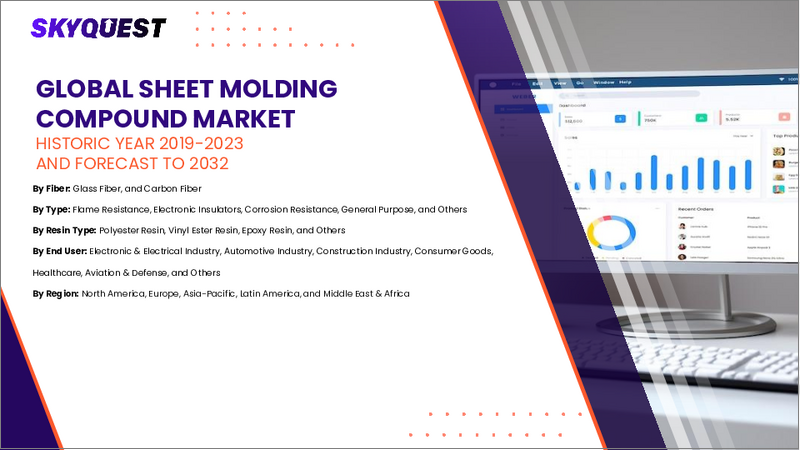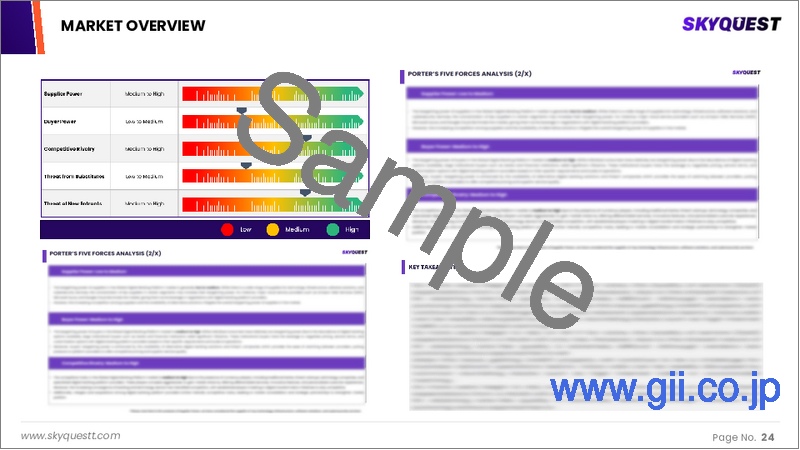|
|
市場調査レポート
商品コード
1605413
シートモールディングコンパウンドの市場規模、シェア、成長分析、タイプ別、最終用途別、地域別 - 産業予測、2024年~2031年Sheet Molding Compound Market Size, Share, Growth Analysis, By Type (Glass Fiber, Carbon Fiber), By End Use, By Region - Industry Forecast 2024-2031 |
||||||
|
|||||||
| シートモールディングコンパウンドの市場規模、シェア、成長分析、タイプ別、最終用途別、地域別 - 産業予測、2024年~2031年 |
|
出版日: 2024年12月03日
発行: SkyQuest
ページ情報: 英文 157 Pages
納期: 3~5営業日
|
全表示
- 概要
- 目次
シートモールディングコンパウンドの世界市場規模は、2022年に13億6,000万米ドルと評価され、2023年の14億2,000万米ドルから2031年には19億9,000万米ドルに成長し、予測期間(2024-2031年)のCAGRは4.30%で成長する見通しです。
世界のシートモールディングコンパウンド(SMC)市場は、そのユニークな性能特性と、自動車、消費財、建設、電気分野を含む多様な用途への適合性により、牽引力を増しています。SMCは現在、用途の広さでは短繊維熱可塑性プラスチック(SFT)の後塵を拝しているが、優れた表面仕上げと機械的特性により、その認知度は高まっています。SMCの特筆すべき利点には、高い機械的強度、耐食性、耐熱性、軽量化、卓越した電気的性能、低排出ガスなどがあり、鋼鉄、鉄、アルミニウムといった従来の材料に代わる魅力的な選択肢となっています。メーカーが軽量かつ高性能の素材を優先する中、SMCは、特に軽量で耐久性に優れ、燃費と全体的な性能を向上させる輸送分野で好まれる選択肢となりつつあります。業界の熱硬化性複合材料へのシフトは、金属コストの上昇とそれに伴う固有の制約によって、自動車メーカーが鉄鋼依存からSMCのような材料への移行を促していることが背景にあります。この動向はさらに、材料の重量と燃料消費量との間に直接的な相関関係があるという認識の高まりによって支えられており、軽量コンパウンドの幅広い採用を促しています。ソリッドコンパウンドと高度な軽量材料の需要が拡大し続ける中、SMC市場は大きな成長を遂げ、さまざまな産業で技術革新を促進し、製造方法を変革する態勢が整っています。
目次
イントロダクション
- 調査の目的
- 調査範囲
- 定義
調査手法
- 情報調達
- 二次データと一次データの方法
- 市場規模予測
- 市場の前提条件と制限
エグゼクティブサマリー
- 世界市場の見通し
- 供給と需要の動向分析
- セグメント別機会分析
市場力学と見通し
- 市場概要
- 市場規模
- 市場力学
- 促進要因と機会
- 抑制要因と課題
- ポーター分析と影響
- 競争企業間の敵対関係
- 代替品の脅威
- 買い手の交渉力
- 新規参入業者の脅威
- 供給企業の交渉力
主な市場の考察
- 重要成功要因
- 競合の程度
- 主な投資機会
- 市場エコシステム
- 市場の魅力指数(2023年)
- PESTEL分析
- マクロ経済指標
- バリューチェーン分析
- 価格分析
- 技術の進歩
- 規制情勢
- ケーススタディ
- 原材料の分析
シートモールディングコンパウンドの市場規模:タイプ別& CAGR(2024-2031)
- 市場概要
- ガラス繊維
- カーボンファイバー
シートモールディングコンパウンドの市場規模:最終用途別& CAGR(2024-2031)
- 市場概要
- 電子・電気産業
- 自動車産業
- 建設業界
- 消費財
- ヘルスケア
- 航空・防衛
- その他
シートモールディングコンパウンドの市場規模:地域別& CAGR(2024-2031)
- 北米
- 米国
- カナダ
- 欧州
- 英国
- ドイツ
- スペイン
- フランス
- イタリア
- その他欧州地域
- アジア太平洋
- 中国
- インド
- 日本
- 韓国
- その他アジア太平洋地域
- ラテンアメリカ
- ブラジル
- その他ラテンアメリカ地域
- 中東およびアフリカ
- GCC諸国
- 南アフリカ
- その他中東・アフリカ
競合情報
- 上位5社の比較
- 主要企業の市場ポジショニング(2023年)
- 主な市場企業が採用した戦略
- 市場の最近の動向
- 企業の市場シェア分析(2023年)
- 主要企業の企業プロファイル
- 会社概要
- 製品ポートフォリオ分析
- セグメント別シェア分析
- 収益の前年比比較(2021-2023)
主要企業プロファイル
- Menzolit
- Polynt S.p.A
- DIC Corporation
- Changzhou Tianma Group Co., Ltd.
- Core Molding Technologies
- Molymer SSP Co., Ltd.
- Showa Denko K.K.
- Devi Polymer Private Limited
- Astar S.A.
- Toray International
- Mitsubishi Chemical Group Corporation
- IDI Composites International
結論と推奨事項
Global Sheet Molding Compound Market size was valued at USD 1.36 billion in 2022 and is poised to grow from USD 1.42 billion in 2023 to USD 1.99 billion by 2031, growing at a CAGR of 4.30% during the forecast period (2024-2031).
The global sheet molding compound (SMC) market is gaining traction due to its unique performance characteristics and suitability for diverse applications, including automotive, consumer goods, construction, and electrical sectors. While SMC currently trails behind short fiber thermoplastics (SFT) in application scope, it is increasingly recognized for its superior surface finish and mechanical properties. Notable advantages of SMC include high mechanical strength, corrosion and thermal resistance, weight reduction, exceptional electrical performance, and low emissions, making it an attractive alternative to traditional materials like steel, iron, and aluminum. As manufacturers prioritize lightweight and high-performance materials, SMC is becoming a preferred choice, particularly in the transportation sector, where its lightweight and durable nature enhances fuel efficiency and overall performance. The industry's shift towards thermoset composites is driven by rising costs of metals and the inherent limitations associated with them, prompting automobile manufacturers to transition from steel dependency to materials like SMC. This trend is further supported by increasing awareness of the direct correlation between material weight and fuel consumption, incentivizing a broader adoption of lightweight compounds. As the demand for solid compounds and advanced lightweight materials continues to swell, the SMC market is poised for significant growth, fostering innovation and transforming manufacturing practices across various industries.
Top-down and bottom-up approaches were used to estimate and validate the size of the Global Sheet Molding Compound market and to estimate the size of various other dependent submarkets. The research methodology used to estimate the market size includes the following details: The key players in the market were identified through secondary research, and their market shares in the respective regions were determined through primary and secondary research. This entire procedure includes the study of the annual and financial reports of the top market players and extensive interviews for key insights from industry leaders such as CEOs, VPs, directors, and marketing executives. All percentage shares split, and breakdowns were determined using secondary sources and verified through Primary sources. All possible parameters that affect the markets covered in this research study have been accounted for, viewed in extensive detail, verified through primary research, and analyzed to get the final quantitative and qualitative data.
Global Sheet Molding Compound Market Segmental Analysis
Global Sheet Molding Compound Market is segmented by Type, End Use, and region. Based on Type, the market is segmented into Glass Fiber, and Carbon Fiber. Based on End Use, the market is segmented into Electronic & Electrical Industry, Automotive Industry, Construction Industry, Consumer Good, Healthcare, Aviation & Defense, and Other. Based on region, the market is segmented into North America, Europe, Asia Pacific, Latin America and Middle East & Africa.
Driver of the Global Sheet Molding Compound Market
The global Sheet Molding Compound (SMC) market is significantly driven by the rising number of vehicles, particularly the increasing demand for commercial passenger vehicles. In 2022, global sales of passenger cars reached approximately 57.5 million, marking a 1.9% growth from the previous year. China stood out as the leading market, accounting for nearly 23.6 million units sold. SMC has gained traction within the automotive sector due to its ability to provide a favorable strength-to-weight ratio, which is crucial for reducing overall vehicle weight. Additionally, regulatory pressures surrounding fuel efficiency and emissions have prompted manufacturers to seek out lightweight materials like SMC, further propelling market growth.
Restraints in the Global Sheet Molding Compound Market
The Global Sheet Molding Compound (SMC) market faces significant restraints that could impede its growth. One of the primary challenges is the barriers to recycling, which complicate the overall sustainability of the material. Additionally, the high costs associated with the necessary infrastructure and the increasing complexity of recycling processes further contribute to these limitations. Furthermore, the diverse availability of alternative products in the market presents a considerable challenge, as consumers may opt for more readily accessible alternatives. These factors combined may hinder the anticipated growth of the SMC market during the forecast period.
Market Trends of the Global Sheet Molding Compound Market
The Global Sheet Molding Compound (SMC) market is experiencing robust growth, driven by a compound annual growth rate (CAGR) fueled by the rising preference for bio-based materials, particularly within the automotive sector. Original Equipment Manufacturers (OEMs) are increasingly prioritizing weight reduction and improved fuel efficiency, leading to a shift towards lightweight SMC alternatives over conventional materials like aluminum and steel. SMC's unique advantages, including its exceptional durability and resistance to impacts, dings, dents, and corrosion, make it an appealing choice for automakers seeking to enhance vehicle performance. This trend highlights a broader movement towards sustainable materials in manufacturing processes, positioning SMC at the forefront of innovation.
Table of Contents
Introduction
- Objectives of the Study
- Scope of the Report
- Definitions
Research Methodology
- Information Procurement
- Secondary & Primary Data Methods
- Market Size Estimation
- Market Assumptions & Limitations
Executive Summary
- Global Market Outlook
- Supply & Demand Trend Analysis
- Segmental Opportunity Analysis
Market Dynamics & Outlook
- Market Overview
- Market Size
- Market Dynamics
- Driver & Opportunities
- Restraints & Challenges
- Porters Analysis & Impact
- Competitive rivalry
- Threat of substitute
- Bargaining power of buyers
- Threat of new entrants
- Bargaining power of suppliers
Key Market Insights
- Key Success Factors
- Degree of Competition
- Top Investment Pockets
- Market Ecosystem
- Market Attractiveness Index, 2023
- PESTEL Analysis
- Macro-Economic Indicators
- Value Chain Analysis
- Pricing Analysis
- Technological Advancement
- Regulatory Landscape
- Case Studies
- Raw Material Analysis
Global Sheet Molding Compound Market Size by Type & CAGR (2024-2031)
- Market Overview
- Glass Fiber
- Carbon Fiber
Global Sheet Molding Compound Market Size by End Use & CAGR (2024-2031)
- Market Overview
- Electronic & Electrical Industry
- Automotive Industry
- Construction Industry
- Consumer Good
- Healthcare
- Aviation & Defense
- Other
Global Sheet Molding Compound Market Size & CAGR (2024-2031)
- North America, (Type, End Use)
- US
- Canada
- Europe, (Type, End Use)
- UK
- Germany
- Spain
- France
- Italy
- Rest of Europe
- Asia-Pacific, (Type, End Use)
- China
- India
- Japan
- South Korea
- Rest of Asia Pacific
- Latin America, (Type, End Use)
- Brazil
- Rest of Latin America
- Middle East & Africa, (Type, End Use)
- GCC Countries
- South Africa
- Rest of Middle East & Africa
Competitive Intelligence
- Top 5 Player Comparison
- Market Positioning of Key Players, 2023
- Strategies Adopted by Key Market Players
- Recent Developments in the Market
- Company Market Share Analysis, 2023
- Company Profiles of All Key Players
- Company Details
- Product Portfolio Analysis
- Company's Segmental Share Analysis
- Revenue Y-O-Y Comparison (2021-2023)
Key Company Profiles
- Menzolit
- Company Overview
- Business Segment Overview
- Financial Updates
- Key Developments
- Polynt S.p.A
- Company Overview
- Business Segment Overview
- Financial Updates
- Key Developments
- DIC Corporation
- Company Overview
- Business Segment Overview
- Financial Updates
- Key Developments
- Changzhou Tianma Group Co., Ltd.
- Company Overview
- Business Segment Overview
- Financial Updates
- Key Developments
- Core Molding Technologies
- Company Overview
- Business Segment Overview
- Financial Updates
- Key Developments
- Molymer SSP Co., Ltd.
- Company Overview
- Business Segment Overview
- Financial Updates
- Key Developments
- Showa Denko K.K.
- Company Overview
- Business Segment Overview
- Financial Updates
- Key Developments
- Devi Polymer Private Limited
- Company Overview
- Business Segment Overview
- Financial Updates
- Key Developments
- Astar S.A.
- Company Overview
- Business Segment Overview
- Financial Updates
- Key Developments
- Toray International
- Company Overview
- Business Segment Overview
- Financial Updates
- Key Developments
- Mitsubishi Chemical Group Corporation
- Company Overview
- Business Segment Overview
- Financial Updates
- Key Developments
- IDI Composites International
- Company Overview
- Business Segment Overview
- Financial Updates
- Key Developments






